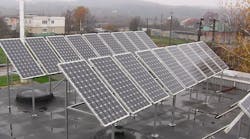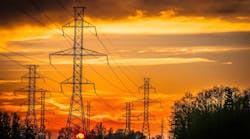We see stories all the time about microgrids and how they are helping address resiliency, economic and sustainability issues as well as fight crime, solve world hunger and on and on. The term “microgrid” is bandied about so readily; do we even know what they are? Are they the universal problem solver or are we being fed fake news?
The term “microgrid” appears to have become “a thing” with the growing popularity of distributed energy resources (DERs). This is supported by the definition given to microgrids by the U.S. DOE Microgrid Exchange Group as a group of interconnected loads and DERs within defined electrical boundaries that act as a single controllable entity with respect to the grid. Another definition suggests that a microgrid normally operates connected to and synchronous with the centralized electrical grid, but can also disconnect or be “islanded” to function autonomously based on economic or physical conditions. I tend to believe the normal mode of a microgrid is a design factor to be determined by its maker.
My all-time favorite microgrid supports this last point. The Si2 Solar Impulse aircraft is recognized as a high technology microgrid system with solar panels, electric motors and battery storage, all designed to operate independently from the grid. The Si2 completed the first ever around the world, manned, solar-powered flight on July 25, 2016. There’s stunning photos and video footage on ABB’s website of the Solar Impulse’s flight quest and mission to stimulate interest in renewable energy.
So what is the difference between a microgrid and a dedicated, two-way distribution feeder? Are they owned and built by the utility or privately? A microgrid and a dedicated circuit with generation, such as solar panels might look essentially the same, except in legal terms and the protection equipment. Of course, a key precept of the microgrid is that it should have the capability to operate even when disconnected from the grid. The elephant in the room may be who owns the infrastructure.
Some of the press about microgrids concerns projects designed and operated by utilities as demonstration projects. Central Electric Cooperative took the demonstration idea a step further when it designed a microgrid to increase the reliability of a business park that houses its own data and operations center (see T&D World April 2017). The cooperative employs self-healing technology and a distribution management system with fault location, isolation and restoration to improve reliability on its microgrid system. A battery energy storage system is used to mitigate the impact of solar intermittency and the system is equipped with a 750 kW diesel backup generator.
Other press about microgrids such as projects at major corporate and institutional complexes, college campuses and government facilities is the stuff of nightmares for utilities that are not providing microgrid equivalent services for customers. Digital technology, declining costs of solar panels, storage and various generation options make microgrids a viable alternative for a much broader spectrum of the market today. However, the off grid option it is not a slam dunk. On a kilowatt-hour basis utilities can be very competitive. If utilities have helped their customers take maximum advantage of energy efficiency, peak-shaving and possibly some demand response, customers may be better off using microgrids as a backup only option. That’s the good news for the historical utility model.
The bad news for the old utility model is that customers may be searching for an option with long term energy supply stability. They may want a provider that will make any needed infrastructure upgrades on behalf of the customer and also take responsibility for design, operation, warranty and financing risks on a turnkey basis. There are companies, including some regulated utility affiliates, who will do that for customers today. Such models may involve third party ownership or public private partnerships that shelter the customer from most project risks and allow the project to take advantage of otherwise unavailable investment tax credits.
The prolific news about microgrids is definitely not fake news. FERC’s new proceeding on the resiliency of the bulk power system could ultimately lead to even more attention regarding the role of microgrids in local markets. It is conceivable that microgrids will lead to the same magnitude of disruptive change in the power sector as did independent power projects in the 1980’s and 1990’s.
Schneider Electric along with Duke Energy Renewables developed a unique “Microgrid-as-a-Service” approach for Montgomery County, Maryland to finance multiple DERs, build two advanced microgrids, and support critical infrastructure upgrades, with no up-front capital. This industry-leading approach allows the County to focus on solving the issues faced at many large facilities: energy resiliency, infrastructure modernization, long-term stable energy cost, and third-party ownership, operation, maintenance and financing. Word to the wise utilities out there: figure out how to be a player and not an observer.


